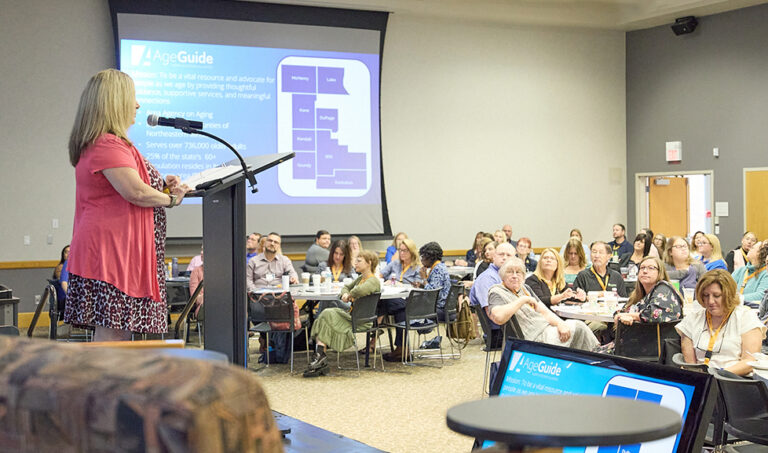
Julie is a communications professional and writer who focuses on healthcare and technology issues.
Look outside the box to pay for long-term care
Ask someone about their ideal living situation in their golden years, and they’ll likely say they hope to live a healthy, independent life into their 90s.
In many cases, though, that’s not the reality. An estimated 17% of adults age 75 to 84 and 42% of adults age 85 and up will require long-term support and services at some point, according to the AARP Public Policy Institute.
Paying for long-term care can be daunting. According to AARP, the average yearly cost is $100,400 for a private room in a nursing home, $48,000 for a one-bedroom apartment in an assisted living facility, and $34,300 for 30 hours of home healthcare per week.
But there are ways to defray the cost of that care. Here are four ideas to help your loved one find the funds to pay for some of their long-term care services.
1. Apply for a limited long-term care policy
Eleven percent of adults 65 and older have long-term care insurance, according to the Urban Institute. However, such policies are expensive and require medical underwriting.
For example, according to the American Association for Long-Term Care Insurance, a 55-year-old couple can expect to pay $2,080 a year for a policy providing a life total of $165,000 in long-term care benefits for each person. If they chose a policy that would increase their benefit amount by 3% a year, they could expect to pay $5,025 a year in premiums.
Limited benefit long-term care policies offer another option, says Sandra Gentry, an agent and unit field trainer for Bankers Life. Such policies have lower premiums and it may be easier to medically qualify for them, but they have a limited cash benefit (for instance $50 to $250 a day) and a reduced amount of time that you can use the benefits, such as over one or two years instead of three to six years.
Another option is a rider, or additional supplemental coverage, on a permanent life insurance policy (which is a type of life insurance that doesn’t expire). The rider enables a policyholder to tap a portion of their death benefits to pay for long-term care costs, Gentry says.
2. Apply for a reverse mortgage
A reverse mortgage is a type of loan that lets people 62 and older convert the equity in their home into cash. The loan is repaid when the borrower has left the house, usually meaning the borrower has died or sold the home. The borrower doesn’t have to make monthly mortgage payments, but they still have to pay property taxes and homeowners insurance.
Early in the 2000s, reverse mortgages had a bad reputation because they didn’t take into account whether an older homeowner could afford to pay their property taxes and insurance. However, reverse mortgages have been modified in recent years to protect the borrower by making sure they have the funds to continue paying those costs over the expected life of the loan.
Reverse mortgages are now a viable option for older homeowners who have equity in their home and want to tap into those funds to pay off a current mortgage or pay for other expenses such as home healthcare, explains Terri Brady, a reverse mortgage specialist with American Advisors Group.
Brady offers the example of a 90-year-old woman who owns a home worth $200,000. She could get a reverse mortgage for up to 70% of the appraised value and use the funds to pay for a few years of in-home care. Then, she could sell the home, pay off the reverse mortgage, and use the remaining proceeds to pay for an assisted living community.
3. Sell the home and use the proceeds to pay for care
Older adults often use the proceeds from the sale of their home to pay for long-term care. Using a senior relocation service to manage the sale and move can make that process go smoothly and quickly, says Nan Hayes, chief revenue officer of Moving Station.
Moving Station provides accurate home values, home sale options (such as immediate home purchase programs and traditional sale), and resources for downsizing and decluttering. Senior living communities and home care companies hire Moving Station to support their clients, so there is no cost to families.
“These types of tasks often become the responsibility of the adult children of aging parents, but … it is always less stressful, easier on relationships, and well worth it when families engage with a professional resource,” Hayes says.
4. Sell gold and silver valuables
Money to pay for long-term care may literally be sitting in the house. Selling valuables such as gold jewelry, gold coins, or sterling silver flatware and serving pieces is another option to raise money for long-term care.
David Kaz, who owns DMK Metal, buys gold and silver jewelry, sterling flatware and serving pieces, old coins, and other gold and silver items that can be refined for reuse.
Homeowners can reap anywhere from about $1,000 to $3,000 for a set of sterling flatware and several thousand for a collection of gold and silver jewelry, Kaz says. While that’s not enough to pay for skilled nursing care or assisted living, it can pay for minor expenses or the modest remodeling of a home to help an older adult age in place.
Yes, long-term care is expensive. But by tapping into multiple sources of funding, older homeowners and their loved ones can find resources to chip away at the cost.












